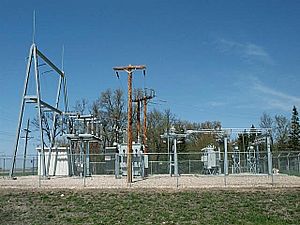Recloser facts for kids
A recloser is a special kind of circuit breaker that can automatically turn the power back on after it has been shut off due to an electrical problem. Imagine a switch that can reset itself! This is super helpful because many electrical problems, like a tree branch briefly touching a power line, fix themselves quickly. By using reclosers, power companies can make sure you have electricity more often and for longer periods.
Contents
What is a Recloser?
A recloser is an automatic switch used in electrical power systems. Its main job is to detect when there's a problem, like a short circuit, and quickly turn off the power to prevent damage. But unlike a regular fuse or circuit breaker that stays off until someone manually resets it, a recloser tries to turn the power back on a few times. If the problem is gone, the power stays on! If the problem is still there, the recloser will eventually stay off, letting engineers know there's a serious issue.
Why Do We Need Reclosers?
Think about your home's electricity. Sometimes, a power outage happens because of something temporary, like a strong gust of wind blowing a tree branch onto a power line for a second. Without a recloser, this brief contact would cause a regular circuit breaker to trip, and your power would stay off until someone from the power company came to reset it.
Reclosers prevent these long outages. They act like a quick check-up:
- First trip: Power goes off for a moment.
- Reclose attempt: The recloser tries to turn the power back on.
- If problem is gone: Power stays on, and you might not even notice a flicker!
- If problem is still there: The recloser tries again, maybe once or twice more. If the problem persists, it will then stay off, protecting the system and signaling that a repair is needed.
This makes the electricity supply much more reliable for homes and businesses.
How Does a Recloser Work?
Reclosers use special sensors to detect unusual electrical currents, which happen during a fault. When a fault is detected, a mechanism inside the recloser quickly opens, stopping the flow of electricity. After a very short time (often less than a second), it automatically closes again. This process is called "reclosing."
Modern reclosers are often controlled by computers. These smart reclosers can be programmed to try reclosing a certain number of times and wait for specific amounts of time between attempts. They can even communicate with the power company's control center, sending information about where and when problems are happening.
Where Are Reclosers Used?
Reclosers are mostly found in outdoor power lines, especially in areas where power lines are exposed to weather, trees, and animals. You'll often see them on utility poles in neighborhoods, rural areas, and at substations. They are a key part of the "distribution" system, which is the part of the power grid that delivers electricity from larger power stations to your homes.
History of Reclosers
The idea of automatically restoring power has been around for a long time. Early versions of reclosers were developed in the mid-20th century to improve the reliability of electrical grids. As technology advanced, reclosers became more sophisticated, moving from simple mechanical devices to complex electronic systems that can make smart decisions about power flow. This continuous improvement helps ensure that our modern world has the steady electricity it needs.
Images for kids



